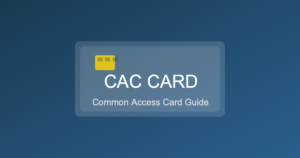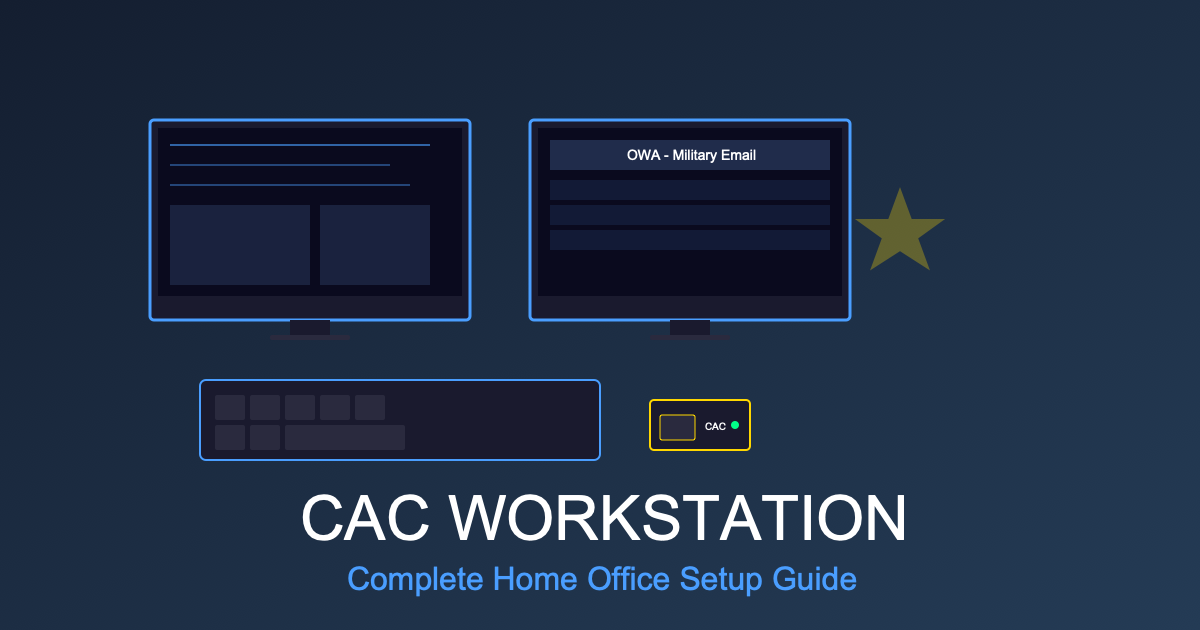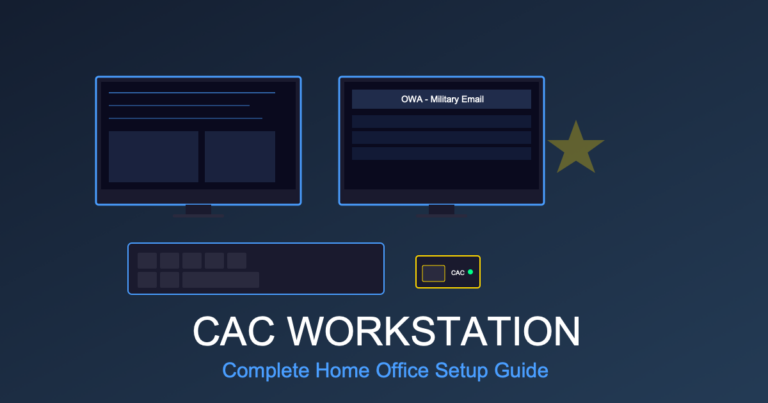Best Laptops for CAC Card Access: Remote Military Work 2025
Choosing the right laptop for CAC card access is critical for military personnel, DoD civilians, and government contractors who work remotely. Your laptop must have the right ports (especially USB-C for modern CAC readers), sufficient processing power for VPN and security software, and compatibility with DoD systems. The wrong laptop creates frustrating compatibility issues that disrupt mission-critical work.
This comprehensive guide reviews the best laptops for CAC access in 2025, covering budget, mid-range, and premium options. We focus on essential features: USB-C ports for modern CAC readers, VPN performance, Windows compatibility, and real-world reliability for remote DoD work.
Essential Features for CAC-Compatible Laptops
Before reviewing specific models, understand what makes a laptop suitable for CAC access and remote military work.
USB Connectivity Requirements
Must-have: At least one USB-C port or multiple USB-A ports
- USB-C (Type-C): Modern CAC readers use USB-C; future-proofs your setup
- USB-A (Standard USB): Legacy CAC readers still common; at least 2 ports recommended
- USB 3.0 or higher: Required for fast CAC reader communication
- USB hub alternative: If limited ports, plan to purchase quality USB-C hub
Why this matters: CAC readers occupy one USB port. You’ll need additional ports for mouse, keyboard, external monitor, and other peripherals during remote work.
Operating System Requirements
Strongly recommended: Windows 10 or Windows 11 Pro
- Windows compatibility: DoD systems, VPNs, and middleware (ActivClient) optimized for Windows
- Pro edition: Supports enterprise security features required by some DoD networks
- macOS possible: Requires additional middleware configuration; not all DoD systems compatible
- Linux/ChromeOS: Not recommended; significant compatibility challenges
Performance Specifications
Minimum specs for smooth DoD system access:
- Processor: Intel Core i5 (11th gen or newer) or AMD Ryzen 5 (5000 series or newer)
- RAM: 16GB minimum (8GB struggles with VPN + multiple applications)
- Storage: 256GB SSD minimum (512GB recommended for comfort)
- Display: 1920×1080 (Full HD) minimum for readable documents and forms
Why these specs: VPN software, ActivClient, Outlook with heavy email, and browser-based DoD applications running simultaneously require solid performance. Underpowered laptops create frustrating lag.
Build Quality and Reliability
- Battery life: 8+ hours for uninterrupted work during power outages or mobile work
- Build durability: Sturdy construction for military moves and travel
- Warranty and support: Minimum 1-year warranty; 3-year preferred
- Repairability: Accessible service centers for rapid repair (important for OCONUS)
Best Overall: Microsoft Surface Laptop (2024)
Key Specifications:
- 13.8″ PixelSense touchscreen (2304 x 1536)
- Qualcomm Snapdragon X Elite (12-core ARM processor)
- 16GB RAM, 1TB SSD
- 2x USB-C 4.0 ports, 1x USB-A port
- Windows 11 Copilot+ PC
- Up to 20 hours battery life
- Weight: 2.96 lbs
Why It’s Best for CAC Work
The 2024 Surface Laptop provides the perfect balance of performance, portability, and connectivity for remote DoD work:
- Dual USB-C 4.0 ports: Connect modern USB-C CAC reader while leaving second port for docking station or charging
- USB-A port included: Works with legacy CAC readers without adapter
- Exceptional battery life: 20 hours means full workday plus evening without charging
- Windows 11 Pro compatible: Full DoD system compatibility, runs ActivClient and all middleware flawlessly
- Premium build quality: Alcantara keyboard deck, durable aluminum chassis survives military moves
- Microsoft support: Excellent warranty service and enterprise support options
CAC Setup Experience
Surface Laptop works seamlessly with CAC readers:
- Install InstallRoot DoD certificates (10 minutes)
- Install ActivClient or middleware (15 minutes)
- Plug in USB-C CAC reader (no driver installation needed with most readers)
- Insert CAC and access DoD systems immediately
USB-C 4.0 ports provide faster data transfer than older USB standards, improving CAC reader response time.
Considerations
- Premium price: $1,400-$1,800 range (worth it for professionals who rely on laptop daily)
- ARM processor: Snapdragon X Elite is ARM-based; vast majority of Windows software compatible, but occasional niche DoD application may have compatibility quirks
- Limited ports: Only 3 total USB ports; may need USB-C hub for extensive peripheral setup
Best For
- Senior officers, GS-12+, and contractors with equipment stipends
- Frequent travelers who need lightweight + long battery life
- Users who want premium build quality and Microsoft ecosystem integration
- Remote workers who can expense or get reimbursed for equipment
Best Mid-Range: HP 15 Laptop 2024 Business
Key Specifications:
- 15.6″ Full HD (1920 x 1080) display
- Intel Core i5-1135G7 (11th gen, 4-core)
- 16GB DDR4 RAM, 512GB SSD
- 1x USB-C (5Gbps), 2x USB-A 3.0
- HDMI, SD card reader
- Windows 11 Pro
- Weight: 3.75 lbs
Why It’s Best Mid-Range Option
The HP 15 Business delivers solid performance at a price most military personnel can afford:
- Windows 11 Pro included: Full enterprise features without upgrade cost
- 16GB RAM standard: Handles VPN, Outlook, browser tabs, and DoD applications simultaneously without lag
- 512GB storage: Sufficient for OS, applications, and years of documents/emails
- Multiple USB options: USB-C for modern CAC readers, 2x USB-A for legacy readers or peripherals
- Full-size keyboard with numpad: Excellent for data entry on military forms
- HP reliability: Proven track record in government/enterprise use
CAC Compatibility
HP 15 works well with both modern and legacy CAC readers:
- USB-C support: Use USB-C CAC reader for clean, modern setup
- USB-A fallback: Two USB-A ports mean you can use government-issued CAC reader while keeping ports available for mouse/keyboard
- Proven compatibility: Intel processors have excellent ActivClient and middleware support
Considerations
- Heavier than premium laptops: 3.75 lbs isn’t ideal for frequent travel
- Standard build quality: Plastic chassis less durable than metal premium laptops
- Battery life: 6-8 hours typical; need charger for full workday
- Display: Standard 1080p panel adequate but not as sharp as premium options
Best For
- Mid-grade enlisted and junior officers purchasing personally
- Government civilians (GS-7 to GS-11) buying without stipend
- Contractors on personal budget
- Home office setup (not frequent travel)
- Users who need solid performance without premium price
Best Budget: ANTEMPER 2025 15.6″ Laptop
Key Specifications:
- 15.6″ Full HD (1920 x 1080) display
- Intel Celeron N100 processor (4-core)
- 16GB DDR4 RAM, 512GB SSD
- USB-C port, 2x USB-A ports
- WiFi 6, Bluetooth 4.2
- Windows 11 Pro
- Weight: 3.5 lbs
Why It’s Best Budget Option
The ANTEMPER laptop offers surprisingly solid specs at budget price:
- 16GB RAM: Same RAM as laptops costing 2-3x more; enables smooth multitasking
- 512GB SSD: Sufficient storage for typical DoD work
- Windows 11 Pro included: No need to upgrade to Pro edition
- USB-C included: Can use modern CAC readers despite budget price
- WiFi 6: Latest wireless standard for better home network performance
- Price point: $300-$400 range makes it accessible for all ranks/grades
CAC Compatibility
Despite budget pricing, works well with CAC readers:
- USB-C port: Connect modern USB-C CAC reader directly
- USB-A ports: Compatible with legacy CAC readers government may issue
- Windows 11 Pro: Full ActivClient and DoD middleware support
- Adequate performance: Celeron N100 handles VPN, browser, and Outlook (not demanding applications like video editing)
Realistic Expectations
What it handles well:
- CAC login to webmail (OWA)
- Browser-based DoD systems (DTS, MyPay, etc.)
- Microsoft Outlook email
- Office 365 (Word, Excel, PowerPoint)
- VPN connections
- Video calls (Teams, Zoom)
What will struggle:
- Heavy multitasking (15+ browser tabs + Outlook + video call)
- Video editing or graphics work
- Virtual machines
- Gaming
Considerations
- Celeron processor: Entry-level CPU; adequate for basic DoD work but noticeably slower than i5/i7
- Build quality: Budget materials; handle carefully
- No-name brand: Limited warranty support compared to HP/Dell/Lenovo
- Battery life: 4-6 hours typical; need to stay near charger
Best For
- Junior enlisted purchasing personally
- Reservists/Guard who need occasional CAC access
- Backup laptop for primary laptop failures
- Light users (email and browser-based systems only)
- Users on strict budget who need functional CAC access
Laptop Comparison Table
| Feature | Surface Laptop (Premium) | HP 15 Business (Mid-Range) | ANTEMPER (Budget) |
|---|---|---|---|
| Price Range | $1,400-$1,800 | $500-$700 | $300-$400 |
| Processor | Snapdragon X Elite (12-core) | Intel i5-1135G7 (4-core) | Intel Celeron N100 (4-core) |
| RAM | 16GB | 16GB | 16GB |
| Storage | 1TB SSD | 512GB SSD | 512GB SSD |
| USB-C Ports | 2x USB-C 4.0 | 1x USB-C 5Gbps | 1x USB-C |
| USB-A Ports | 1 | 2 | 2 |
| Display | 13.8″ 2304×1536 touch | 15.6″ 1920×1080 | 15.6″ 1920×1080 |
| Battery Life | Up to 20 hours | 6-8 hours | 4-6 hours |
| Weight | 2.96 lbs | 3.75 lbs | 3.5 lbs |
| OS | Windows 11 (Pro-capable) | Windows 11 Pro | Windows 11 Pro |
| Best For | Professionals, frequent travelers | Most military/DoD users | Budget-conscious, light users |
Essential CAC Accessories for Your Laptop
Regardless of which laptop you choose, you’ll need these accessories for optimal CAC access:
CAC Card Reader (Required)
Your laptop doesn’t include a CAC reader – you must purchase separately:
- USB-C CAC readers: For laptops with USB-C ports (future-proof)
- USB-A CAC readers: For legacy ports or if you prefer standard USB
- TAA-compliant readers: Required for some government purchase programs
Recommendation: See our complete guide to the best CAC card readers for 2025 with verified DoD-compatible models.
USB-C Hub/Docking Station (Highly Recommended)
If your laptop has limited USB ports, a hub enables multiple peripheral connections:
- Connect CAC reader, mouse, keyboard, external monitor simultaneously
- Choose hub with 4+ USB ports plus HDMI
- USB-C hubs with Power Delivery charge laptop while providing ports
External Monitor (Optional but Valuable)
Remote DoD work often involves multiple windows/applications:
- Minimum: 24″ 1920×1080 monitor
- Recommended: 27″ 2560×1440 for comfortable viewing
- Connection: HDMI or USB-C DisplayPort
- Benefit: Laptop screen for email, external monitor for documents/forms
Privacy Screen Filter (Security)
For working in public spaces or shared offices:
- Blocks screen visibility from side angles
- Prevents shoulder surfing of sensitive information
- Size-specific to your laptop screen (13.3″, 15.6″, etc.)
- Required by some DoD security policies when working in public
Setting Up Your Laptop for CAC Access
After purchasing your laptop, follow these setup steps for CAC compatibility:
Step 1: Windows Configuration
- Update Windows: Settings → Windows Update → Check for updates (install all)
- Verify Windows 11 Pro: If Home edition, upgrade to Pro for enterprise features
- Enable BitLocker: Encrypt drive for DoD security requirements
- Configure power settings: Prevent sleep during long VPN sessions
Step 2: Install DoD Certificates
- Visit
https://public.cyber.mil/pki-pke/tools-configuration-files/ - Download latest InstallRoot utility
- Right-click and “Run as Administrator”
- Complete installation (installs all DoD root certificates)
- Restart computer
Step 3: Install CAC Middleware
Depending on your organization:
- ActivClient: Most Army and Air Force users (download from your organization)
- Tumbleweed: Some Navy and contractor organizations
- OpenSC: Open-source alternative if ActivClient unavailable
Step 4: Test CAC Access
- Connect CAC reader to USB port
- Insert CAC card (chip facing up)
- Open browser and navigate to
https://webmail.apps.mil - When prompted, select your CAC certificate
- Enter PIN
- Verify successful login
If login fails, see our Chrome CAC certificate errors troubleshooting guide.
Frequently Asked Questions
Can I use a Mac for CAC access?
Yes, but with limitations:
- Requires CACKey or OpenSC middleware installation
- Some DoD systems have macOS compatibility issues
- VPN software may have limited Mac support
- Windows laptops strongly recommended for seamless compatibility
Do I need a specific USB port for CAC readers?
USB-C is preferred (modern, fast), but USB-A works fine. Most important: ensure you have USB 3.0 or higher (blue interior port or marked “SS”). USB 2.0 ports (black interior) work but are slower.
Will my organization provide a laptop for remote work?
Varies by organization:
- Active duty military: Usually provided (Government Furnished Equipment)
- Government civilians: Often provided for remote workers
- Contractors: Rarely provided; usually personal purchase or company-issued
- Reservists/Guard: Rarely provided; personal purchase common
What if my laptop doesn’t have USB-C?
Use USB-A CAC reader instead. USB-A readers work identically to USB-C readers, just use older port style. You can also purchase USB-C to USB-A adapter if you already own USB-C reader.
How long do these laptops typically last for DoD work?
- Premium laptops (Surface): 5-7 years with proper care
- Mid-range (HP Business): 4-5 years
- Budget (ANTEMPER): 2-3 years
Performance degradation and software requirements increase over time; plan replacement accordingly.
Final Recommendations
Best Overall Choice: Microsoft Surface Laptop
If budget allows, the Surface Laptop is worth the investment. Exceptional battery life, premium build quality, perfect port selection (USB-C + USB-A), and lightweight design make it ideal for military professionals who depend on their laptop daily.
Best Value: HP 15 Business Laptop
For most military personnel and DoD civilians, the HP 15 Business offers the best balance of performance, features, and price. Windows 11 Pro included, solid specs, and proven reliability make it the smart choice for typical remote work needs.
Best Budget: ANTEMPER Laptop
If you’re on a tight budget or need light CAC access, the ANTEMPER laptop delivers surprising value. It won’t win performance awards, but handles basic DoD work competently at a price anyone can afford.
Next Steps After Purchasing
Once you’ve purchased your laptop:
- Order CAC reader: See our best CAC card readers guide for verified compatible readers
- Install DoD certificates: Download and run InstallRoot
- Configure middleware: Install ActivClient or equivalent
- Test access: Verify webmail and DoD systems work before relying on laptop for mission-critical work
- Consider accessories: USB hub, external monitor, privacy screen as budget allows
This article contains affiliate links. Purchases made through these links help support free DoD IT guides and tutorials. All product recommendations are based on actual compatibility and performance for CAC access.
Related Guides:












